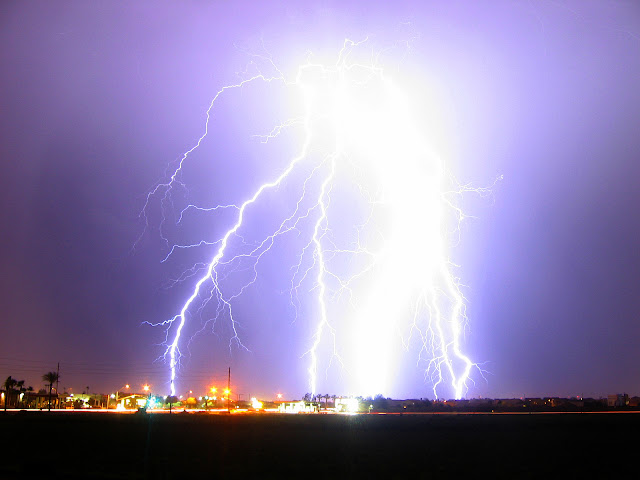Photo: Making Friends with the Very Small
"...to boldly go where no one has gone before..." Sure, it's a tagline from Star Trek, but it applies to photography also.
It's one of the reasons for photography, I think...to see things no one else can see. To really stop, and really LOOK, and get down on your hands and knees and see things you never knew about before. And, more importantly, to try to record those things after you've seen them.
That's why I'm into close-up photography, or "Macro" photography.
Did you know bees wear fur?
Did you know beetles have spikes on their collars, like a natual built-in punk rocker fashion design?
You can't make out a bug's fashion sense from five or six feet in the air...you have to climb down to his level, look him in the eye, ask him nicely to hold still...and hope he's in an agreeable mood...
I enjoy shooting bugs and flowers and water droplets and anything else that will sit still long enough for me to zoom in on it. I experimented first with the lead figures from role-playing games, years ago; recently, I've been experimenting with bugs like poisonous insects and spiders, rocks and crystals, and baby hands and feet.
The perfect macro photography setup includes a camera built for macro, proper lighting, a tripod, and a subject that holds perfectly still. Back in the real world, however, this is a difficult proposition. Most bugs don't sit still while you bring the camera down to point-blank range. Yes, that's generally the way to get a macro shot--hold the camera scant inches from the subject. That's also why the "perfect setup" rarely happens, because most macro subjects aren't content to stand still and be photographed. This is where the photographer needs to know his camera.
This series of a wasp was taken "photo-journalist" style. I saw the wasps flying around a bush, set the camera for macro, and tried to chase the wasp with the lens. I know my camera auto-focuses at about three inches, so when I thought the wasp was the right distance, I snapped the picture. I never looked through the viewfinder; I just kept the camera close to the wasp, tried to estimate where the lens was pointing, and snapped the shots. I stopped shooting and gave them a break after ten or twelve pictures because I thought they were getting a bit upset (they were flying faster and buzzing louder). They were off to another neighborhood the next day.
Scorpions aren't something I want to shoot "in the wild" because they are *way* too fast for my comfort. So, for this series, friends caught me a pair of scorpions, and I used a shoebox full of rocks as a photo studio. I didn't have the nerve to hold the camera two inches from the subject; I actually shot these from a foot away, zoomed in as heavily as I could.
And when I saw a thick spider web near my garage door, I knew I had to do something to protect my family from the black widow that built it. But first, I grabbed my camera. I generally don't like the idea of murdering my models when the photoshoot is over (even the scorpions above were released back into the wild), but in this case I had to make an exception.
And finally, every special occasion where the other half receives flowers is also an opportunity to experiment with the artistry in any blossom.
Recently, people have been experimenting with "homemade extreme macro." It takes a bit of work, but the payoff is worth it. The challenge is to mount the lens *backwards* on the camera, in front of another lens (like taking a standard 35mm lens and holding it in front of the digital camera, so that the digital is staring back through it). There are several companies offering adaptor rings that allow the photographer to connect the lenses "wrong end first," and several people have made their own jury-rigged brackets.
The end result, though, is that the backwards lens functions as a mega-macro lens. Pictures of matchheads look like the surface of an alien planet. When focusing on an insect, the photographer is forced to narrow down the field of view to one wing or even one eye. For one example on how to do this, check out http://www.photocritic.org/2005/macro-photography-on-a-budget/
Regardless of what level of "macro" you're looking for, though, you've still got to be willing to get up close and personal with your subjects. Don't be afraid to make friends with the very small.


Comments